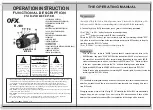
page 88
MARK-V FT-1000MP Operating Manual
D
OWNLOADING
MARK-V FT-1000MP D
ATA
On command, the MARK-V FT-1000MP will down-
load some or all (1,863 bytes) of its operational data.
This data block contains all current transceiver settings.
In addition, the current meter indication (Tx or Rx) is
read, digitized and returned as well. This provides a
wealth of information in near real-time that can be pro-
cessed by your program or the running application for
control purposes or display readouts. By regular or in-
termittent requests for this data, the program (and you)
can be kept continuously up-to-date on the status of
the MARK-V FT-1000MP operating environment.
The following four commands cause the MARK-V
FT-1000MP to download various operational and in-
ternally stored settings via the
CAT
port:
Status Update
(10H) - causes the transceiver to
return all or portions of its RAM table (up to 1,863 bytes).
Status Flags Request
(FAH) - obtains only the first
6 bytes (the Status Flags), plus 2 extra “Model ID” bytes
(10H and 00H).
Read Meter
(F7H) - returns the meter deflection (0
- FFH) repeated in four bytes, followed by one “filler”
byte (F7H).
Pacing Command
(0EH) - Each byte of returned
data may be delayed by an interval determined by this
command (0 to 255 ms in 1-ms steps). This delay is
initially zero until the Pacing command is sent (see note
below).
Note: Pacing allows returned data to be read and
processed by slower computers. However, set it
as short as your computer will allow, to minimize
the inconvenience of the delay. Sending all 1,863
bytes requires just under 5 seconds with zero-
length delay selected, but over 5 minutes if the
maximum delay is selected!
S
TATUS
U
PDATE
D
ATA
O
RGANIZATION
An overview of the Status Update Data that can be
returned to the PC in response to one of the Status
Update requests (opcodes 10H, FAH, F7H, or 0EH) is
shown next page. The 1,863-byte block begins with
six bytes, each containing one-bit state Status Flags
(A), for a total of 48 bits, followed by one byte indicat-
ing the current (or last selected) Memory Channel (B),
followed by 116 x 16-byte data records: one for the
current Operating Data (C), one each for VFO-A (D)
and VFO-B (E), and one for each of the 113 memories
(F).
Of the four commands that cause Status Update to
be returned, remember that only opcode 10H (with its
last argument set to zero) returns all of the data (see
bottom left of this page).
STATUS FLAGS (BYTES 1~ 6)
Each of the first six bytes are subdivided into 1-bit
flag fields: if a bit is set (1), the function is enabled
(on); and if reset (0), the function is disabled (off). These
flags reflect the current states of various transceiver
functions, most of which appear in the radio display as
indicators or LEDs. The Status Flags command returns
these bytes for use in the control program (you could
replicate these indicators on the computer display, or
else use them as control flags for routines, etc.). Bit
offsets for all six bytes is shown on page 89.
MEMORY CHANNEL DATA (BYTE 7)
The seventh Update Data Byte contains a binary
value from 00 ~ 70H, corresponding to the current
memory channel number on the display. Only this byte
is returned by sending the Status Update command
with the first parameter set to 1. The chart on page 90
lists the corresponding hexadecimal codes for memory
channels 01 ~ 99, P1 ~ P9, and QMB memories 1 ~ 5.
16-BYTE DATA RECORDS (BYTES 8 ~ 1863)
The remainder of the operational data returned by
the Status Update command consist of 16-byte data
records, indicating VFO and memory-specific selec-
tions. The first of these records is for the current dis-
play, followed by the VFO-A, VFO-B, and then the 113
memory channels, from lowest to highest. Please re-
view the table at the top left column on page 91, which
outlines the structure of a 16-byte data record. Each
byte is identified by its offset from the start (base ad-
dress) of the record. A further breakdown of each byte
offset is also provided.
Note that this same 16-byte data record format is
used for the VFO and Memory Data as well, unless
you are currently operating on a retuned memory (“M
TUNE” displayed).
CAT System Computer Control
Parameter
U = 00H
U = 01H
U = 02H
U = 03H
U = 04H
ø
X =
00 ~ 71H
Bytes
Returned
1,863
1
16
32
(2 x 16)
16
NA
Data
Returned
All Status
Updata Data
Memory
Channel No.
Current
Operating Data
(VFO or Memory)
Main VFO-A &
Sub VFO-B Data
Memory Data
Comment
See above Box
-
Pacing Command
Current or Last
Selected Memory
See the Tables on
page 91 and 92 for
16-byte data record
structures
X = Momory (1~99, P1 ~ P5, Q1 ~ Q5)
ø
only used when U = 04H
















































